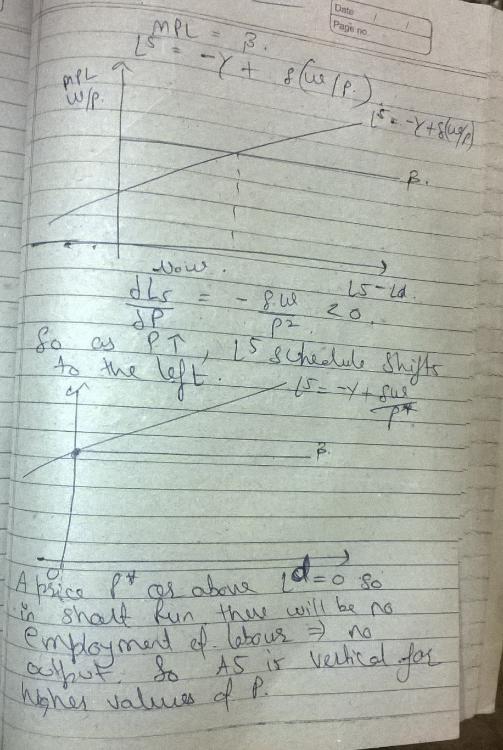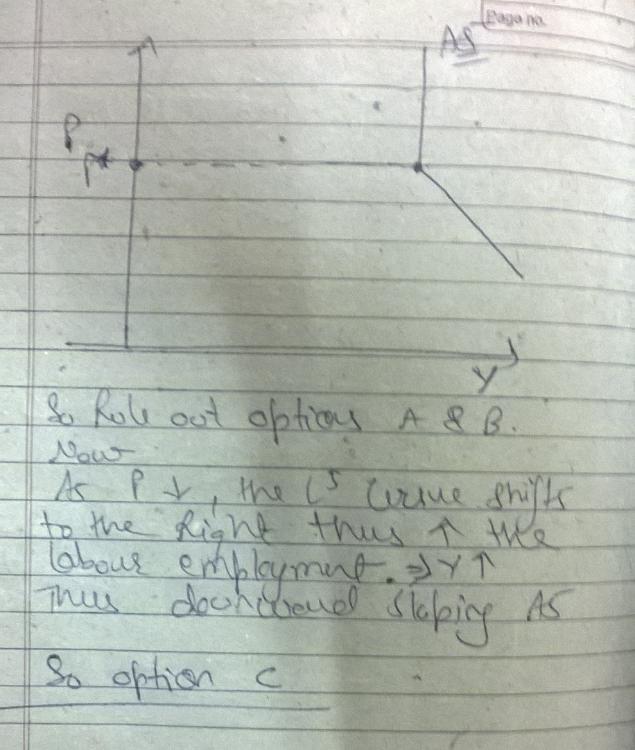Dse 2010 Q44
|
http://economicsentrance.weebly.com/uploads/1/1/0/5/1105777/option-a-2010.pdf
Please help me with questions 44-46.Thank You |
|
44.From the given information you can get the output
Y= aK + b(-g + dW/P) where a is alpha , b is beta g is gamma d dis delta Now for very high P, W/P=0 so Y is vertical for a moderate P, as P increases Y decreases, so in the Y-P domain the slope is negative which brings us to option c. I'm not sure how we get it as vertical for low P. It might be because infinite Y is not possible. 45.For a given P, Y is increased because K is increased, so it should shift right 46.I'm not sure why the answer is shift up, to me it should shift right. Since Nominal wage is increased W increases for a given P. which results in Y increasing for a given P which is shift right. |
|
In reply to this post by The Villain
@Ron....I try this but I'm not so sure.....if we consider AS-AD curve then what happened....1st case is increased in production by 1 unit increase in Capital....then AS curve shift rightward...
|
|
next problem is if Nominal Wage is increased then it is done by the Producer Side....Ld curve shift to right...so as a consequence, the Ls curve is shifted up....plz let clarify
|
|
@phelps....i think ur approach is quite ok...still i didnt get.How is it vertical?
|
|
Ron, for very high P, since W/P=0 , Y=aK-bg. Y is not affected by P so it is vertical as price is in Y axis and output is in X axis.
(I'm not 100 percent sure abt the below) When price is low ie. approx =0 it should produce infinite Y, however this can be considered as a maximum value(say Ymx) that Y attains when output is low. So for lower prices it produces Ymx just like for higher prices it produces Y=ak-bg. In both the cases it is a constant and does not vary with P, so the aggregate supply curve is vertical. |
|
In reply to this post by The Villain
ques 44
 
Akshay Jain
Masters in Economics Delhi School of Economics 2013-15 |
|
Thanks Akshay. Can you suggest a book(or material) that explains derivation of Aggregate Supply from Labour Supply and Labour Demad. Blanchard explains AS from price and wage setting which is different. Thanks!
|
|
Do it from Branson...

Akshay Jain
Masters in Economics Delhi School of Economics 2013-15 |
|
In reply to this post by Akshay Jain
Que. 21.(2010) Consider a closed economy.If the nominal wage is flexible and nominal money supply is increased, then which of the following will be in equlibrium?.
A. Real wage decreases and real money supply decreases. B.Real wage decreases and real money supply increases. C.Real wage is unchanged and real money supply is unchanged. D.Real wage decreases and real money supply is unchanged. Please some one explain this question.Answer is D. |
|
@ASH ....When all markets ie money market, goods market and labour are in equilibrium that is the AD =AS holds at a stable output ie at natural rate of output so that expected price level = actual price level.
If money stock increases the LM curve initially will shift to the right and So does the AD curve. Now in equilibrium output is greater than the natural level of output and actual price level is greater than expected price level. This price level difference will hv two effects, one on the asset market and other on the Labor market but these effect will move simultaneously. In asset market, since price level has risen this will force LM to shift leftward but this would not shift the AD Curve. Nd in labour market since actual price level is greater than expected price level, this will shift the AS curve upward to the left. The LM will shifts left to its original location and at the new equilibrium will reach where again natural level of output = actual level of output and thus expected price level =actual price level but this level will be comparatively higher from the original value. Since LM is back to its original position therefore real money supply is unchanged but price level do hv increased thus the real wage rate ie nominal wage/price level have fallen. |
|
The answer given bt Amit sir is c, Real wage is also unchanged.
@Vaibhav, dont u think by Wage setting this price movement will be anticipated and the Nominal wages will also increase such that W/P is unchanged? Thanks for your explanation. |
|
In reply to this post by Akshay Jain
@akshay , can u plz explain the third portion of option c,i.e "for low values of P it will be vertical again" ?why is it so? |
|
In reply to this post by phelps.phan
OK I did a silly mistake.....when wage setters set revises their expected price level which is now increased will definitely increase the nominal wage rate, W, since wage setting relation can be written as W=Pe*(1-au+ c)
So W increases one for one increase in Pe...thanks Phelps |
|
Oh ya answer is C only. Got it now. Thanks for the explanation Vaibhav and phelps. :')
|
|
In reply to this post by The Villain
can somebody also explain q 46
m not able to understand the shift up or right options essentially bcz of the shape of AS curve please please explain this q thanx :) |
|
Draw the SRAS curve first....Y=aK + (W/P)*L now simplify it Y=a'(intercept) + b'/P.....(a'=aK, b'=WL) so it gives a downward sloping AS curve....now if the intercept changes ie K increases by one-unit, then it shifts to right.....now if Nominal Wage increases then slope changes that means it shifts along the curve...W increases then it is shifts up along the AS curve....@ Akshay plz ceck & comment
|
|
Can someone please explain question 37 from this paper? The buy one get one scheme question..? [Link to paper - http://economicsentrance.weebly.com/uploads/1/1/0/5/1105777/option-a-2010.pdf ] Shouldnt the correct answer be x*/2 < xd < x* and yd> y* I say this because preferences are well behaved. Therefore substitution effect will make him want more of x* than before ( and he gets 2xd in this case) and income effect will induce him to desire more of both goods. |
|
How can be "b" be slope . What you have written is not even linear in terms of P and Y . ? I still have this confusion. Is this because when W increases P increases to keep real wage same? Anyone please answer .
|
«
Return to General Discussions
|
1 view|%1 views
| Free forum by Nabble | Edit this page |



